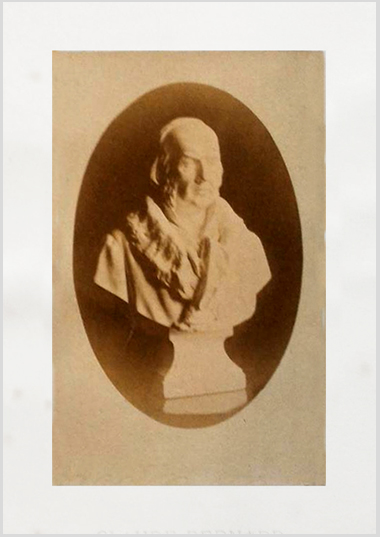
Meulan : Imprimerie de la Société Zoologique de France, 1886.
Description : [iv] p., [1 l.] pl., [2 fold. l.] figs., [1]–275 p., [1] p. adv., [9 l.] pl. ; ill.: 1 phot., 29 text figs., tbls. ; 25.2 cm.
Photograph : albumen on printed leaf, depicting a marble bust of Claude Bernard. Photo exposed by the light of firefly.
Photographer : fire beetle (Pyrophorus noctilucus).
Subject : Enzymes — Luciferase, luciferin ; bioluminescence.
Notes :
Une dentelle de papier noirci fut appliquée sur une plaque photographique au gélatino-bromure contenue dans un châssis à épreuves positives. La lumière destinée à impressionner la plaque venait d'un des deux organes lumineux du prothorax, l'autre envoyait ses rayons principaux à peu près parallèlement à la surface impressionnable qu'il éclairait cependant un peu d'un côté : l'Insecte était maintenu à environ deux centimètres de distance de la vitre du châssis.
Afin d'obtenir un résultat décisif, la plaque fut exposée pendant une heure à la lumière de l'Insecte constamment excité: l'action fut des plus intenses, il nous parut évident qu'une exposition beaucoup plus courte serait suffisante; en effet, nous avons pu réduire le temps de pose, d'abord à vingt minutes, puis à cinq.
Depuis ces premiers essais, j'ai pu obtenir, dans un temps beaucoup plus court (deux minutes), des photographies beaucoup plus grandes (0m20c), en me servant de plaques plus sensibles et en utilisant, cette fois, l'éclairage de l'appareil abdominal.
La plaque sensibilisée était posée horizontalement sur une table et le cliché à reproduire était appliqué directement sur la surface sensible. Sur ces deux plaques de verre, ainsi disposées, on avait placé un petit trépied en verre soutenant une petite cuvette de cristal à fond plat, à une hauteur de deux centimètres environ au-dessus du cliché. Un Pyrophore placé dans cette petite cuvette qui contenait de l'eau, exécutait en nageant des mouvements rapides dans tous les sens; il mettait ainsi à découvert son appareil ventral, qui éclairait fortement la plaque placée au-dessous de lui.
C'est de cette façon qu'a été obtenu le cliché qui a servi pour le tirage de l'épreuve positive, représentant le buste de Claude Bernard, placée en tète de ce mémoire. — Page 124-125.

My copy of the Dubois doctoral thesis substitutes a portrait of Dr. Paul Bert for the frontispiece of Claude Bernard found in the regular edition and shown here. However, the substitution is consonant with an historic fraternity at the laboratory of experimental physiology at the Sorbonne, where the brilliant research of Bernard inspired Bert's equally impressive studies in respiration, and Dubois's subsequent outstanding study in bioluminescence. Dubois was préparateur for Bert at the Sorbonne, as Bert was for Bernard, and each scientist had a turn at directing the labs. The science of comparative physiology found its institutional footing as a separate discipline, largely through the efforts of these three men. The death of Paul Bert weighed on the final preparations of Dubois's doctoral thesis and he arranged for a limited run of commemorative copies bound with the photograph of his mentor.
The photograph of Paul Bert is credited to an anonymous pyrophorus, "Cucujo pinxit," whereas the Claude Bernard portrait photo carries the less playful caption, "Photographie par la lumière animale." The 2 minute exposure of Bernard was accomplished with the light of a luminous click beetle (Pyrophorus noctilucus) swimming in a flat bottom crystal bowl, supported by a tripod 2cm. above the glass negative and sensitized plate below. The experiment was announced, prior to the release of his thesis, in Comptes rendus [..] de la Société de biologie, and was prompted by an earlier discussion in the journal on starlight's weak chemical effect on photographic emulsions as compared to its instantaneous effect on the retina.
Dubois made numerous contributions to the field of comaparative physiology, including important work on hibernation, but his grandest achievement by far was the luciferin-luciferase system which he discovered and named. In biochemistry research today, the luciferin-luciferase system has become indispensible for imaging genetic uptake and function in vivo. In 1887, Dubois left Sorbonne and established a lab in Lyons where he continued his research, publishing on photogenesis in millipedes, mollusks, and bacteria, but also investigating the phenomenon of bioluminescence across the entire animal and vegetable kingdoms, including human cadavers. Dubois also continued his experiments in photographic processes with his "living lamps," notably a study on the photobacterium genus, published in a paper titled, "Sur [..] photographies obtenues par les photobactériacées; lampe vivante" (1901). He successfully isolated alcohol soluble and insoluble compounds from the purpurigenous glands of the purple dye Murex (Murex brandaris) which both remained colorless until mixed, and five years later he perfected this system for use as a permanent photographic process, published in a paper titled, "Nouvelles recherches sur la pourpre du Murex brandaris; action des lumières colorées, teinture, purpuro-photographies" (1907).
